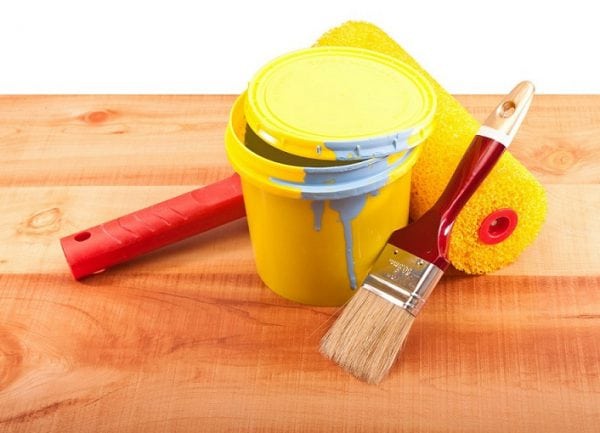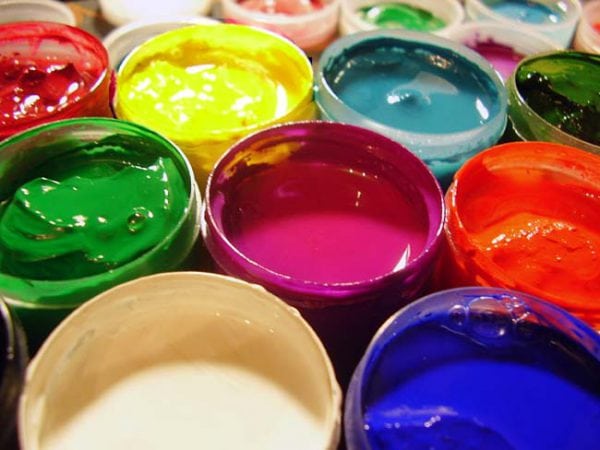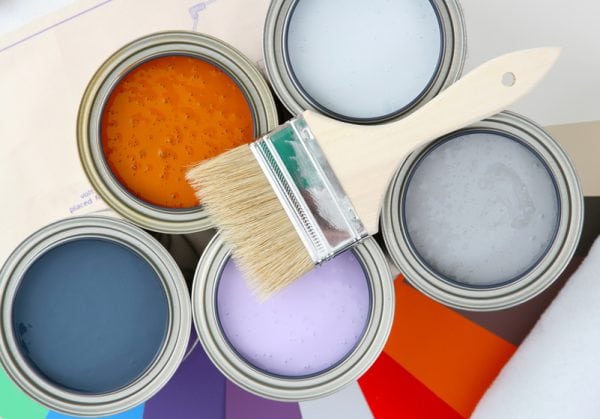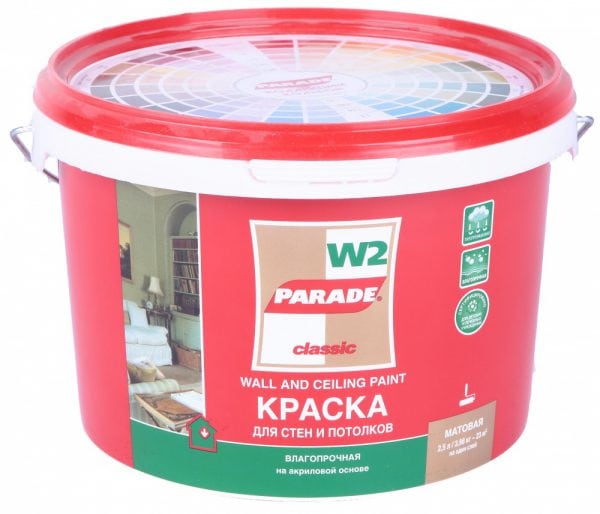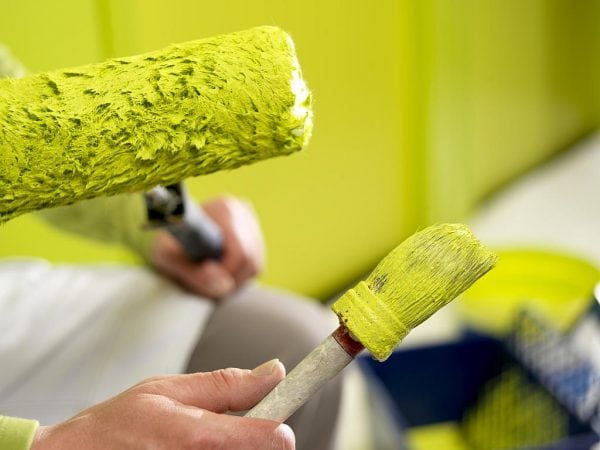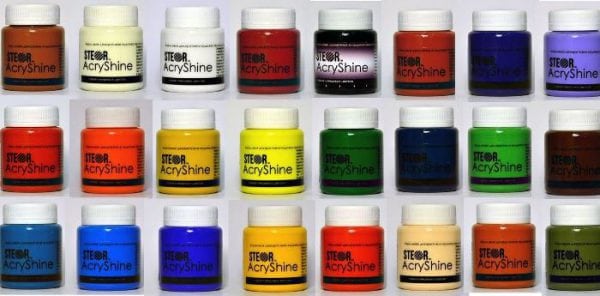Most wood paints have a pungent odor. The smell source is an organic solvent. For example, any alkyd enamel contains white spirit, so the smell is inevitable. However, there is another type of paints and varnishes on the market (LKM), where water is used as a solvent. A characteristic feature of such compounds is the absence of an unpleasant odor.
- Water based paints
- Polyvinyl acetate paints
- Advantages and disadvantages of PVA paints
- Latex water based paints
- Acrylic silicone paints
- Acrylic paints
- Hammer paints
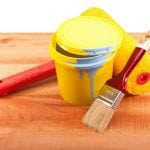
Water based paints
Water-based compounds are divided into two types:
- Water dispersible. Produced on the basis of aqueous dispersions of the polymer component (solid polymer in liquid).
- Water emulsion. They are a subspecies of water dispersion coatings (liquid polymer in a liquid).
Note! Water-dispersion and water-emulsion solutions are very similar. When the emulsion leaves, the plasticizers become solid and acquire hydrophobic qualities.
Latex, a natural or synthetic material, acts as a polymer in water-based paints. In modern paints, a synthetic version of latex is used, which is a dispersion of artificial rubber particles.
There are four types of latex paints:
- styrene butadiene, colloquially called latex emulsion;
- acrylic-polyvinyl acetate;
- acrylic silicone;
- acrylic.
Water-based paints and varnishes are used for all types of wooden products, including:
- window frames;
- sexes;
- furniture;
- entrance and interior doors;
- laminated panels;
- Chipboard, etc.
Water compounds well fit not only on wood, but also on putty.
to contents ↑Polyvinyl acetate paints
Polyvinyl acetate is used as the basis for the production of this type of paint. PVA paint is an emulsion created on the principle of "oil in water".
The components of the paint are:
- An aqueous emulsion based on polyvinyl acetate is the main component of coatings. It has a creamy appearance. Since there is water in the composition of the emulsion, the freezing temperature is critical for the composition — zero degrees Celsius. An unplasticized emulsion is also produced, which is able to endure 3-4 cycles of complete freezing without loss of performance.
- Pigment dyes. These substances give the composition a color.
- Stabilizers. Additives whose task is to give LKM special technical properties.
- Plasticizers. Substances responsible for the physico-mechanical properties of the mixture and the formation of a protective film.
Advantages and disadvantages of PVA paints
The quality of polyvinyl acetate solutions may vary depending on the additives they contain. However, in general, the following advantages of these paints can be noted:
- ease of application to the surface;
- lack of toxic components and smell;
- the ability to close even the smallest cracks in the coating;
- fire safety;
- moisture resistance (this quality applies only to PVA compositions with special additives);
- elasticity, tensile strength;
- resistance to ultraviolet;
- wear resistance;
- the possibility of tinting;
- color stability over the years;
- vapor tightness;
- resistance to fungus and mold;
- good adhesion (adhesive qualities);
- resistance to alkaline compounds;
- low cost.
It is also worth noting that PVA paints are quick-drying (approximately 2-3 hours). The optimum level of air temperature for faster drying ranges from 17 to 23 degrees above zero. When the polyvinyl acetate composition dries, a slightly porous semi-matt film forms on the surface.
PVA solutions also have disadvantages:
- Even after completely dry polyvinyl acetate paint can be washed off, the reason for this lies in its instability to moisture.
- Paints with a class from 0 to 10 have an effect similar to chalk - if you touch a painted surface, a trace will remain on your hand or clothing.
- Weak resistance to low temperatures - polyvinyl acetate paints can not be applied or stored at temperatures below plus 6 degrees.
- For facade work, only water-dispersible compositions in which there are verstate and acrylate components are suitable.
- PVA paints are gradually becoming more expensive due to the complexity of their composition.
- When painting wooden surfaces, a high-quality preparation of the wooden layer is needed - repeated cleaning and grinding of the surface.
Most often, polyvinyl acetate compositions are used for painting those wooden surfaces that are not subject to frequent mechanical contacts and are located in dry places.
Humidity for such paints is destructive. For example, staining windows with polyvinyl acetate solutions is not recommended.
to contents ↑Latex water based paints
Styrene-butadiene paint is a pigment suspension in an emulsion of styrene-butadiene polymer component. The mixture also includes stabilizers, emulsifiers and some other substances.
Paints are pasty. Before use, the styrene-butadiene mixture must be diluted with water. Moreover, soft water is required, since contact with hard water may cause the mixture to coagulate. LKM are applied on the putty and primed surface, although you can do without preliminary surface treatment with these compounds. This type of paint and varnish mixes well with old coatings painted with oil paint. The surface after staining gets a matte or slightly glossy look.
Unlike PVA, styrene-butadiene paints are much more resistant to moisture. In addition, they have better indicators of wear resistance and washability.
Compared to polyvinyl acetate formulations, latex aqueous emulsion paints are not so durable and besides they are inferior in their external attractiveness. It is also worth noting the low light resistance of this type of paintwork. Under the influence of ultraviolet radiation, styrene-butadiene compounds lose their original form. Therefore, the best scope of these coatings is the internal surfaces of the premises. Although it should be noted that there are universal latex aqueous emulsion solutions on the market, which, thanks to the additives available in them, are suitable for processing facades.
The methods of applying this type of coatings have their own characteristics. Particularly good results are obtained by staining with rollers - in this case, the viscosity should be from 45 to 50 seconds according to VZ-4. If the paint is applied with a spray gun, the viscosity level is allowed within 30-33 seconds. But staining with a brush is not recommended, because in this case a long shading is needed, which is unacceptable for this type of paintwork. The composition is applied in two to three layers.
to contents ↑
Acrylic silicone paints
Most often, acrylic-silicone mixtures are water-dispersible. Silicone resins and acrylates act as a base, and water is used as a solvent.
Acrylic-silicone coatings are characterized by a lot of advantages:
- water resistance, due to which the painted wooden coating can be used even in conditions of high humidity;
- resistance to fungus and mold;
- vapor permeability, allowing to ensure a normal level of moisture exchange;
- resistance to ultraviolet radiation, low and sharply changing temperatures;
- dirt-repellent properties - the material does not attract dust, and therefore it is widely used not only for painting the internal parts of the building, but also for facades;
- elasticity, allowing to close slots up to 2 millimeters wide;
- neutral to electric discharges;
- low thermal ductility, as a result of which paintwork does not soften at high air temperature;
- resistance to alkali (unlike acrylic paints);
- the longest service life among all water-based formulations (20-25 years);
- stable brightness and color;
- absolute versatility (acrylic-silicone coatings are applicable not only to wood, but also to almost any other type of materials).
The coating after applying acrylic-silicone paint becomes matte. A variety of pigments can be added to the solution to give the surface the desired color. In some formulations, manufacturing companies make additives that give LKM specific qualities. For example, fireproof acrylic silicone paints are available.
to contents ↑Acrylic paints
Acrylic paints and varnishes include several types of components:
- A binder polymeric substance that provides film formation, adhesive properties, as well as bonding pigments, fillers and other substances together.
- Pigments, which are elements of a finely divided fraction. These substances give the paint color, strength characteristics and corrosion resistance.
- Fillers responsible for the dullness or glossiness of the surface. In addition, fillers protect the paintwork from mold, fungus, bark beetles, moisture, etc.
- Auxiliary components (thickeners, foam dampers, stabilizers, flame retardants, etc.).
There are several types of acrylic paint:
- Acrylic water-dispersion mixture consists of a polymer acrylic emulsion, pigment, water and special additives. The copolymers that make up the emulsion provide a protective film that is highly resistant to external factors.
- Water-based acrylic mixture is usually used for interior decoration. Water-based compositions are among the most popular among consumers, not least due to affordable prices.
- Paints for painting. Acrylic facade coatings for painting are characterized by their all-weather use. In addition to standard paints, special thickened embossed pastes are available. However, paints for painting are characterized by a pungent odor, since they do not use water, but an organic solvent as a diluent.
Advantages of acrylic compositions:
- water repellent characteristics;
- lack of pungent odor due to non-toxic solvent;
- health safety;
- resistance to low temperatures;
- long service life of the coating;
- fire safety;
- low material consumption;
- resistance to ultraviolet radiation;
- vapor permeability (especially important for wooden surfaces);
- quick drying - the drying time of the painted surface can vary from 30 to 120 minutes;
- the ability to work with acrylic composition even in rainy weather;
- color fastness;
- the elasticity of the coating is an important quality for wood prone to deformations under the influence of natural factors, as well as shrinkage at home.
- the ability to remove paint if it gets on an undesirable area;
- affordable cost.
Disadvantages of acrylic coatings:
- Paints from the cheap price range can greatly change as the surface dries.
- You need to be very careful about staining, periodically taking breaks so as not to apply too much paint.
Hammer paints
Although hammer coatings are based on a solvent rather than water, they are considered low odor. Such paints contain a proprietary solvent with additives that weaken the sharpness of the smell. The composition of the mixture includes acrylic elements, epoxy and alkyd resins, silicone and other components.
Hammer paints - These are decorative enamels, after the application of which, a slightly relief decorative protective coating appears on the surface. In appearance, the coating is somewhat similar to the minted surface, the relief of which was formed using a hammer.
Hammer paints are characterized by a number of positive qualities:
- lack of pungent odor;
- heat resistance;
- good adhesion to other materials;
- wear resistance;
- moisture resistance;
- short drying period;
- dust repellent properties;
- stable color and brightness.
This type of composition has only one drawback - high prices.
When choosing an odorless wood paint, you should understand that you have to make a compromise. Any water-based paint will not be able to compete with oil or alkyd formulations in terms of moisture resistance and wear resistance. If these indicators are uncritical, and it is precisely the absence of smell that is important, water-based paints and varnishes are an excellent option, which has many advantages.
If you still have doubts about the choice of composition, you can dispel them after reading the material about wood paints for interior use.

